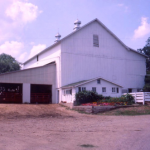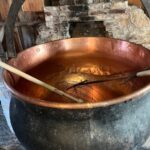When the wheat crop failures of the late nineteenth century jeopardized the incomes of many of Wisconsin’s immigrant farmers, the region’s Swiss population transitioned to a trade that they knew from the Old World: dairying and cheesemaking. To do this, Swiss farmers began to buy herds of milk cows and to construct a large number of dairy barns. One of those them was the Hefty-Blum White Barn which supplied dairy to a number of cheese factories in and around the town of New Glarus. These changes led to the establishment of Green County as one of the highest producers of “foreign type” cheese (Swiss, limburger, and brick cheese).[1]
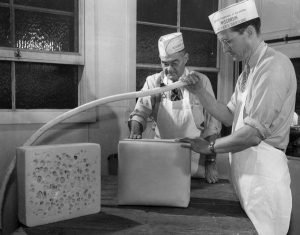
In the early 1800s Switzerland was on the verge of a financial depression that threatened to ruin the country. Due to this, 108 Swiss citizens traveled to the United States of America, quickly bought land in Wisconsin, and settled down in Green County where they founded the town of New Glarus.[2] Before the late 1860s, the main product of Wisconsin was wheat, with the peak of its production occurring in 1860. The popularity of wheat in the mid-1800s led many immigrant farmers to focus on this crop rather than other products they were more used to growing.[3]
While the Swiss immigrants prospered for a number of years by raising wheat crops, poor soil conditions caused by erosion, as well as chinch bugs, led to its rapid decline in Wisconsin in the late nineteenth century.[4] To combat these issues, the farmers and other citizens of Green County and other parts of Wisconsin turned to dairy production. Even the University of Wisconsin strongly supported increasing the dairy industry of the state, and the results of their research such as the Babcock butterfat tester, led to a stronger relationship between the University and the farmers.[5]
Swiss Dairy Farmers in Green County
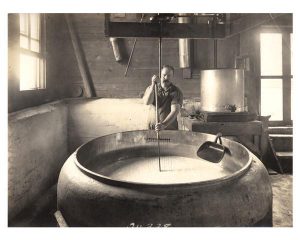
In 1868, Nicklaus Gerber started the very first cheese factory in Green County, a limburger factory, and a few years later he established the first Swiss cheese factory.[6] Following the lead of other Swiss farmers in Green County, Thomas Hefty, a typical Swiss immigrant farmer in Green County, built the Hefty-Blum White Barn in 1878. For the first several years of Thomas’s dairy operation, the milk from the cows housed in the Hefty-Blum White Barn was sent to the cheese factory of a neighboring farm. But from 1881 to 1911 Thomas had an operational cheese factory less than 100 yards from the White Barn, so after the farm hands were done milking the 55 cows in the barn, the milk was easily brought over to the factory for processing.[7]
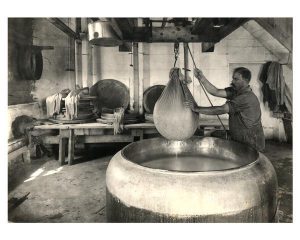
By 1910 there were 222 known cheese factories in Green County alone (including the cheese factory on the Hefty-Blum Homestead), making Green County the number one cheese producing county in Wisconsin.[8] Even after the on-site cheese factory was shut down, the new cold water cooling tank of the barn’s milk house allowed the farmer to better store the dairy before it was shipped to the nearest cheese factory.[9]
While Green County’s cheese production has been surpassed by other parts of the state, it is still one of the highest producing counties of foreign-type cheeses in the state.[10] Immigrant farmers such as Thomas Hefty who daily provided at least 55 cows worth of milk from his Swiss style barn in rural Green County ultimately shaped the image of Wisconsin for generations.
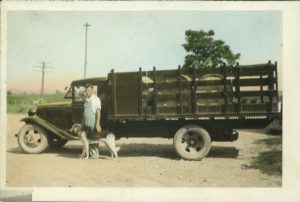
Featured image: Swiss-American Cheese Makers in Monroe, WI., 1920, posing with the tools of their trade. Image courtesy of the Monroe National Historic Cheesemaking Center.
Written by Christopher Sietz.
FOOTNOTES
[1] “History of Cheese.” National Historic Cheesemaking Center. Accessed: 4/12/18, http://www.nationalhistoriccheesemakingcenter.org/history-of-cheese/
[2] Elda and Linda Scheisser. The Swiss Endure. (Printed by: New Glarus Historical Society, 1994), 1-2.
[3] Clarence W. Olmstead. “Changing Technology, Values, and Rural Landscape,” Wisconsin Land and Life. (Madison, WI.: The University of Wisconsin Press, 1997) 362.
[4] “History of Cheese.”
[5] Ingolf Vogeler, “The Cultural Landscape of Wisconsin’s Dairy Farming.” Wisconsin Land and Life (Madison, WI.: The University of Wisconsin Press, 1997), 411.
[6] Schiesser, The Swiss Endure, 5-6.
[7] Fred G. Blum., The Known Evolving History of our White Swiss-American Barn.(From the unpublished memoirs of Fred G. Blum, April 2010), 2.
[8] “History of Cheese.”
[9] Blum, White Swiss-American Barn, 2.
[10] “History of Cheese.”

